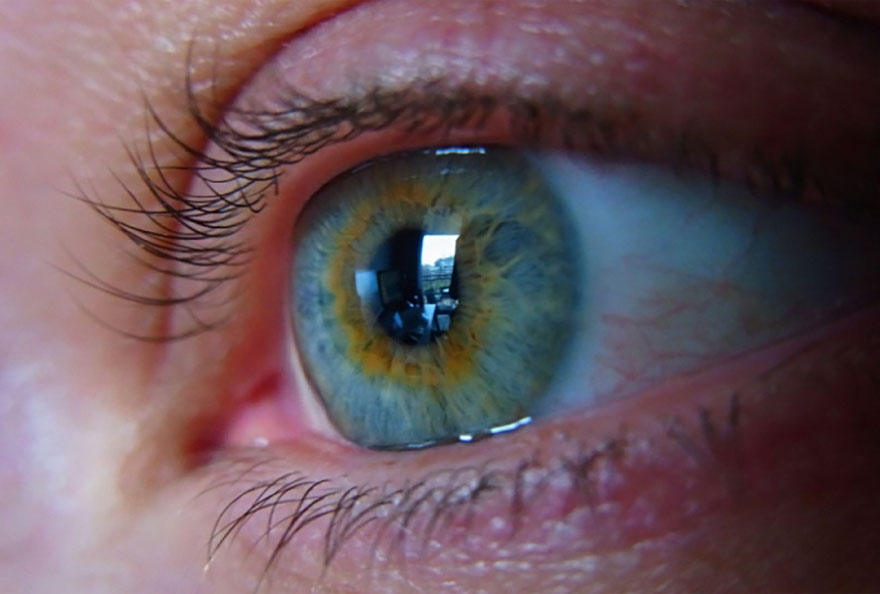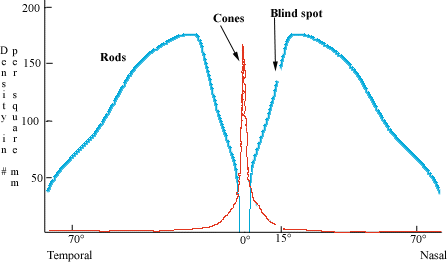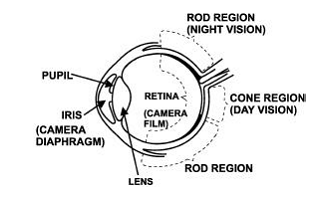Night Vision and the Eye
- November 10, 2015
- JR Grounds
- Philosophy
- 2 Comments

When talking about tactical equipment, the discussion eventually turns to night vision devices and which ones are best, how they work, etc. What I usually find is very few people understand the basics of the eye, and how to improve the ability to operate at night without NVD.
The discussion starts with the anatomy of the eye, and difference between the two receptors, known as rods and cones. I am sure most of you studied this in school, but we have usually forgotten that rods are what can detect low light features, whereas cones detect color, etc.
 If you think of the back of the eye like a pie plate, cones are concentrated in the center of the plate, and the rods are spread around the edges. The rods are sensitive to light and the pupil works to shield them from direct exposure by contracting and darkening the edges of the pie plate.
If you think of the back of the eye like a pie plate, cones are concentrated in the center of the plate, and the rods are spread around the edges. The rods are sensitive to light and the pupil works to shield them from direct exposure by contracting and darkening the edges of the pie plate.
Since rods are the important receptor for night vision, let’s discuss them in basics. They do not have the color sensitivity, and what they can detect is shifted toward the shorter wavelengths, which is why you are able to see green at much lower level light. Rods cannot detect light in the red frequency, which is why you see many red filters on flashlights.
Rods are also much more sensitive to light in general, which allows you to see dimmer lit objects in your peripheral vision than you can see if you are looking right at something. An interesting way to test this is to look at the night sky. You will be able to see a dim star in your peripheral vision, but when you look right at it, the star will disappear. You have moved it in your eye from your rods to your cones.
The other thing the rods are better at “seeing” is movement. You may look directly at an area in the field and not see anything, but by moving your eyes so that same area is in your peripheral, you will detect smaller movements.
The iris muscle controls the opening in the front of the eye (pupil), which controls what part of the eye is actually viewing the world. The pupil can respond in milliseconds, so why is that it takes so long to be able to “see” in the dark? The rods have a  photopigment called rhodopsin, or visual purple, which controls their sensitivity. When exposed to light, the way they protect themselves is by flushing out the rhodopsin. When the light exposure ends, the body slowly starts pumping back in the rhodopsin, and after 30-45 minutes the rod has regained full sensitivity. There is no physical ability to speed up this process, so once your eye is flushed, you are night blind for at least 30 minutes. But since we have two eyes, we have an advantage. If you know you are going on a night op, tape one eye shut for 45 minutes prior to going into the dark. Once out, untape your eye and you will have at least one eye able to see. Try this out tonight on your nightly bathroom visit. Get up from bed, and tightly close one eye. Turn the light on, do your business, all while keeping that eye closed. Turn the light off, and you will notice you are night blind. Now open both eyes, and you will be able to see.
photopigment called rhodopsin, or visual purple, which controls their sensitivity. When exposed to light, the way they protect themselves is by flushing out the rhodopsin. When the light exposure ends, the body slowly starts pumping back in the rhodopsin, and after 30-45 minutes the rod has regained full sensitivity. There is no physical ability to speed up this process, so once your eye is flushed, you are night blind for at least 30 minutes. But since we have two eyes, we have an advantage. If you know you are going on a night op, tape one eye shut for 45 minutes prior to going into the dark. Once out, untape your eye and you will have at least one eye able to see. Try this out tonight on your nightly bathroom visit. Get up from bed, and tightly close one eye. Turn the light on, do your business, all while keeping that eye closed. Turn the light off, and you will notice you are night blind. Now open both eyes, and you will be able to see.
So what does this teach us about night ops? Keep your eyes protected from even brief flashes of white light. Close one eye if you have to use light. Use a scan pattern because your peripheral vision can detect dim light and movement better.
Hope this helps….if nothing else it prevents stubbed toes in the middle of the night.

Someone asked earlier about an old saying of “shoot low in the dark”.
The reason for this is most people do not know their natural point of aim. When they can’t see their sites, they tend to raise their muzzle even higher without realizing it. This obviously leads to shots being too high. To combat this effect, many instructors will tell students to shoot low in the dark. Another way to do it is to lower your stance while in the dark.
I couldn’t have said better myself!